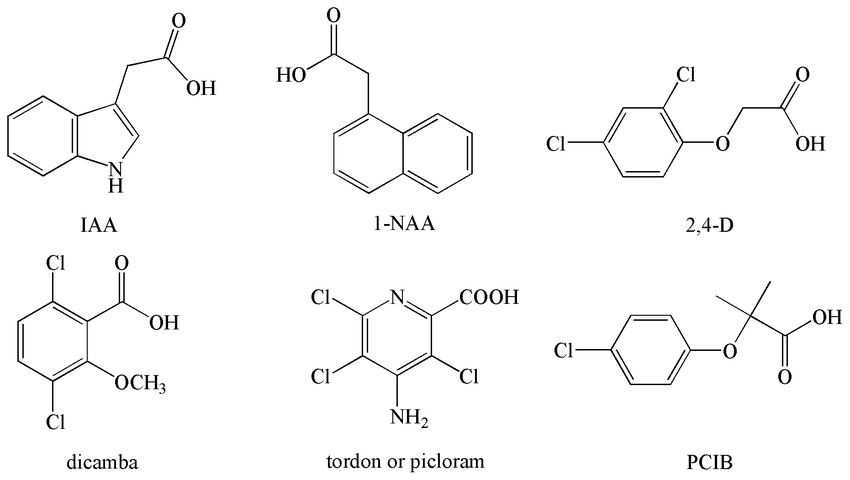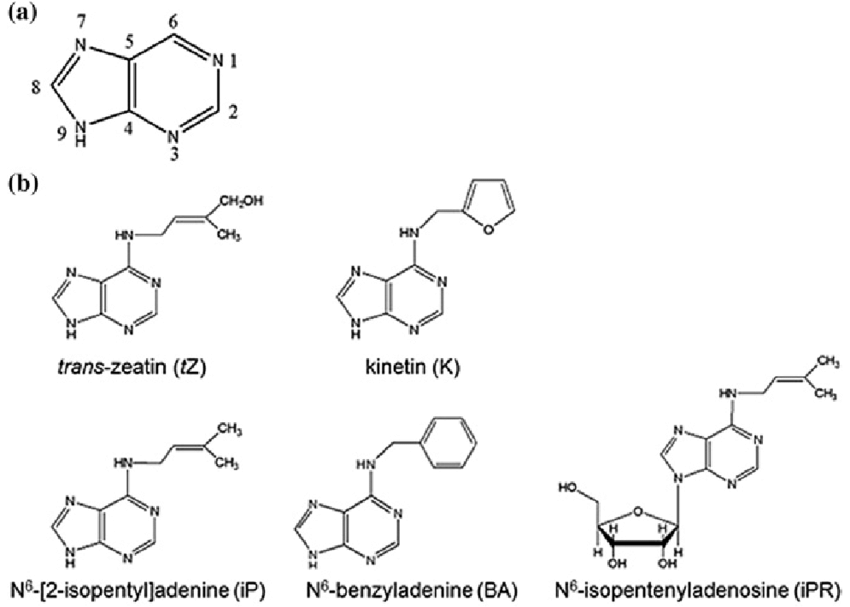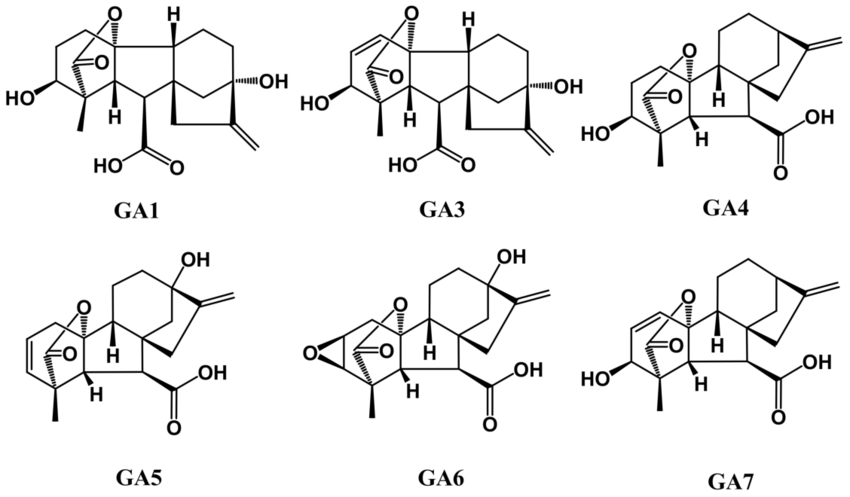Phytohormones: Plant growth hormones (Plant growth regulators)
Numerous chemical compounds known as plant growth regulators or plant hormones have a significant impact on the development and differentiation of plant cells, tissues, and organs. Plant growth regulators serve as cellular messengers by acting as chemicals. At the present time, auxins, gibberellins, cytokinins, abscisic acid (ABA), and ethylene are the five identified categories of plant hormones. They collaborate to control how cells grow and evolve. Ethylene has a minor role in plant tissue culture and is mostly engaged in abscission and floral secrecies. Two other groups, the brassinosteroids and polyamines, appear to occasionally be active in controlling plant development in addition to the five primary growth regulators. Functions of Auxin Cytokinin and Gibberellins will be studied in detail here.
Auxin
Auxin, a growth regulator, has a variety of roles in plant growth and development, including the establishment of the lateral root system, apical dominance, tropisms, and embryo axis.
Auxin is a plant growth hormone that the plant can make chemically or organically. The natural hormone is denoted by the letter IAA, which stands for indoleacetic acid, in biological synthesis. The hormones NAA (naphthalene acetic acid) and IBA are produced chemically. (indolebutynic acid).

Physiological effects of Auxin in Plants
Auxin is the hormone responsible for apical dominancy. Functions of Auxin Cytokinin and Gibberellins. Its functions can be summarized below:
- The primary role of auxin is apical dominance or suppression of lateral buds. Lateral buds grow if the auxin supply is eliminated.
- The dormant state of tubers, corms, and rhizomes inhibits the sprouting of onion, garlic, and potato bulbs.
- Coleoptiles and stems are lengthened by auxin due to cell expansion. In stems and roots, an uneven auxin distribution results in a pattern of differential cell expansion and organ bending. (Phototropism, geotropism).
- In stem cuttings, auxins such IAA, IPA, IBA, NAA, and 2,4-D stimulate adventitious rooting. Common rooting hormone is IBA.
- Auxins like 2,4-D and 2,4,5-T are frequently employed as herbicides or selective weed killers. Agent orange is the name of the 2,4-D and 2,4,5-T cocktail that the USA employed to defoliate forests during the Vietnam War.
- Normally, auxins prevent blooming. Spraying NAA and 2,4-D on Litchi and Ananas, however, encourages blooming.
- To promote parthenocarpy, auxins such as IAA, IBA, NAA, 2,4-D AND 2,4,5-T etc. can be applied as paste to the flower’s stigma. Tomatoes, brinjal, guava, bananas, grapes, papaya, etc. are a few examples.
- Auxins typically prevent ABA from performing its functions. Premature abscission is avoided by exogenous administration of auxins at the base of the petiole or pedicel.
- In the cambial region, auxins encourage cell division, which leads to the development of secondary tissues.
- In tissue culture, auxin causes early xylem and phloem differentiation.
- Geotropism and photoperiodism are also caused by auxins.
- Additionally, it promotes breathing, inhibits lodging, shortens internode, prevents nodule development, etc.
Cytokinins
Plant-specific chemical messengers (hormones) called cytokinins are essential for controlling the plant cell cycle and a variety of developmental processes.
Cytokinin is the plant growth factor that encourages cell proliferation, according to our definition. Together with auxins, cytokinins are known to encourage the cytokinesis process. This hormone is credited with a number of abilities, including wound healing, plant abscission, cell expansion, feminizing effects, promoting shoot development over root growth, and many more.

Physiological effects of cytokinins in Plants
In plant cells, the hormone cytokinin promotes cell division. Functions of Auxin Cytokinin and Gibberellins. The following is a list of cytokinins’ primary functions:
- Cytokinin promotes cell division and aids in the synthesis of DNA and RNA.
- When combined with auxins, cytokinin promotes cell growth in tobacco pith, cotyledons, and leaf discs.
- The use of cytokinins reveals auxins’ contradictory features. If cytokinin and IAA are given to stem cells, lateral bud development is induced.
- Cytokinin in presence of casein hydrolase and IAA stimulates root initiation and development in tobacco stem callus culture at lower concentration.
- Dormancy can be broken by spraying cytokinin (Xanthium, Lactuca).
- Morphogenesis is the process of morphological development of plants in natural condition and from callus in tissue culture. Comparative concentration of cytokinin with auxins shows morphogenesis. High auxin induces root development, low auxin induces bud development.
- In order to create the cambium ring during secondary growth, cytokinin causes the creation of the interfascicular cambium.
- Chlorophyll in removed leaves is not destroyed right away because to cytokinin.
- Cytokinin frequently causes a delay in abscission.
- Because of apical dominancy, the use of cytokinin increases the translocation of dietary material.
- Membrane stability is preserved and membrane breakdown is avoided by cytokinins.
- Additionally, it makes male flowers of some plants into female.
Gibberellic Acids
Gibberellins (GAs), which are tetracyclic diterpenoid carboxylic acids that exist naturally, are in charge of several critical processes, including seed germination, stalk lengthening, flower and fruit development, etc.
The most obvious effect of gibberellins on plant development is the elongation of the stem. When it is administered to a shrub at low concentration, the stem begins to grow. The plants’ internodes lengthen to the point where they blend in with climbing vines. The genetic restrictions in certain dwarf types are overridden by Gibberellins.
More than 70 gibberellins have been isolated. The numbers are GA1, GA2, GA3, and so forth. The most extensively researched plant growth regulator is GA3 gibberellic acid.

Physiological effects of Gibberellins in Plants
Gibberellic acid is important phytohormone responsible for elongation of internode, flowering, seed germination etc. Functions of Auxin Cytokinin and Gibberellins. Major functions are summarized below:
- Gibberellin can treat dwarfism in plants such as peas, maize, barley, and others when administered exogenously in the right amounts.
- Just before the reproductive period, gibberellin stimulates internodal elongation in rosette plants, which is known as bolting and results in a rise in stem height. Consider cabbage.
- Gibberellin therapy can cause seeds that need light to germinate in the dark (like lettuce, barley, and tobacco).
- Breaking dormancy of the lotus seed and buds.
- Auxins are less effective parthenocarpy agents than gibberellin. In pears, apples, tomatoes, drupe, and cucumbers, it causes parthenocarpy.
- It is used to replace vernalization or cold therapy.
- Gibberellins promote the synthesis of lipases, proteases, and amylases, particularly in developing seeds for dissolving storage compounds.
- Cell elongation and cell division. In many deciduous trees, it increases cambial activity.
- Expression of sex and flowering. In plants with long days, it regulates flowering.
- Gibberellic acid frequently inhibits light-induced shoot elongation or etiolation, which results in yellow leaves when exposed to darkness.
- Gibberellin also induces growth in the stem that has been light-inhibited, breaking the dormancy of the potato tubers. It has no impact on rooting, although a heavy dose may impede it.